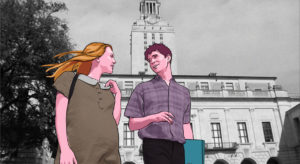 Missed Madison Film Festival
Missed Madison Film Festival
Tower | Keith Maitland | USA | 2016 | 98 minutes
GoWatchIt | Amazon Video | Google Play | iTunes | Vudu
The conceptually ambitious and emotionally evocative documentary Tower uses animated recreations to pay tribute to the victims of Charles Whitman’s sniper attack on the University of Texas campus in 1966.
Update 2/21/17: Tower did make it to Madison. WUD Film featured it at the Union South Marquee Theater on February 17 & 18. Tower can also be streamed through the PBS Independent Lens website and app through March 1, 2017.
I’m posting this review on the day that Oscar nominations have been revealed, and I have to share my disappointment that Tower was not nominated for Best Documentary. It is far superior to at least one of the nominations, Life, Animated, which also uses animation to convey subjective truths rather than just phenomenal reality.
The ambitious Tower assembles a dramatic collage of eye witness and victim accounts of Charles Whitman’s 92-minute sniper attack from the top of the University of Texas Tower on August 1, 1966. The film pays tribute to those whose lives ended or forever changed on that day.
Despite debates about recreations and animation, both techniques are now firmly established as part of a documentarian’s palette. That doesn’t mean that every use of those techniques are ethically or aesthetically sound. Recent examples I haven’t liked include Author: The J.T. Leroy Story (a film I still liked overall) and Life, Animated (a film I didn’t like). In both of those examples, the animation seemed like a desperate attempt to make things more “visual.” The animation in Tower, on the other hand, is both ethically and aesthetically sound. Not only does it permit a vivid recreation of events not documented in archival footage, it also provides opportunities to suggest the subjective experiences of the witnesses and victims.
The animation style is a variation on rotoscoping, where animators start with scenes shot on film or video and draw (or use computers) to animate that footage frame by frame. Director Keith Maitland began with staged recreations of the incident, and also shot recreations of interviews (adapted from a 2002 Texas Monthly article on the incident) using actors. With the Austin connection, it is hard not to think of Richard Linklater and Bob Sabiston’s Waking Life (2001), but here the animation is more reserved while still vividly colorful, allowing room for emotional expression and subjective experience.
While we see and hear a range of experiences and perspectives, the emotional core of Tower concerns the story of pregnant Claire Wilson (Violett Beane) and her boyfriend Tom Eckman (Cole Bee Wilson). They were among the first victims, but while Tom died instantly, Claire lay on the hot concrete in front of University of Texas Tower while others watched her helplessly. Claire survived, and we hear her account of her experience through an interview recreated by Beane. But we also eventually see and hear Claire Wilson James herself, in non-animated recent interviews. The switching back and forth between past and present, animation and recent footage delivers a vivid emotional punch.
The animation provides a degree of abstraction and distancing from the details of the incident without masking the horrors of what happened. Perhaps this distancing effect makes the juxtaposition between the animated, historical Claire and the live-action, contemporary Claire so startling.
While many know the basic story of the Charles Whitman incident, Tower is still dramatically gripping, as we discover which witnesses we meet will take action. The dramatic effect is similar to Man on Wire: we know what happens, but we don’t know how it happens, which remains incredibly suspenseful. Two particularly compelling figures in this regard are John Fox (Séamus Bolivar-Ochoa), who wandered down to the campus out of curiosity and became a hero in Claire’s story, and Ramiro “Ray” Martinez, an Austin police officer who began the day like any other, and emerged as a key figure in storming the Tower to confront Whitman.
The narrative climax, the shooting of Whitman at the top of the Tower, comes with about twenty minutes left in the film. The emotional climax comes afterwards, as Maitland follows up with his subjects and explores how the incident shaped their lives.
Maitland makes a deliberate choice not to explore Whitman’s story, but he does include Claire’s response to a Life Magazine article about Whitman after the incident. Claire responds to a picture of Whitman as a child carrying two rifles, and relates to him as someone who was once a child, a human being. As someone who lost her unborn child that day, she finds it hard to hate Whitman, and on camera she confirms that she has forgiven him.
Strong stuff, and one of several such moments in the last act of Tower. The film foregrounds humanity over horror at a time one might expect something exploitive or less respectful. The end of the film leaves one full of hope, but also full of regret that these survivors had their life paths altered by random violence. A final montage of subsequent mass killings over the last fifty years also reminds us that the violence is not completely random when we have so completely enabled gun culture to survive.
Check out the other Missed Madison Film Festival reviews for Tuesday, January 24:
Joshy reviewed by Chris Lay (guest contributor) at Madison Film Forum»
High-Rise reviewed by Edwanike Harbour at Madison Film Forum»
Dog Eat Dog reviewed by David Klein at LakeFrontRow»